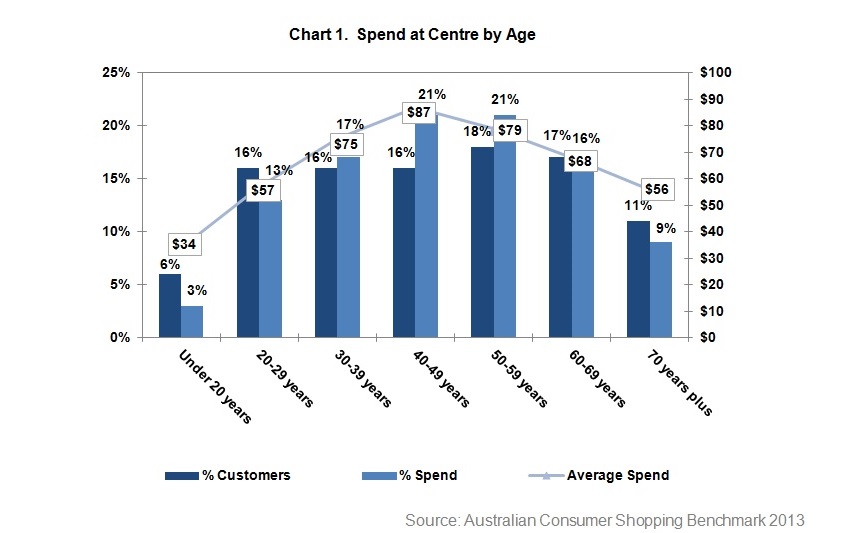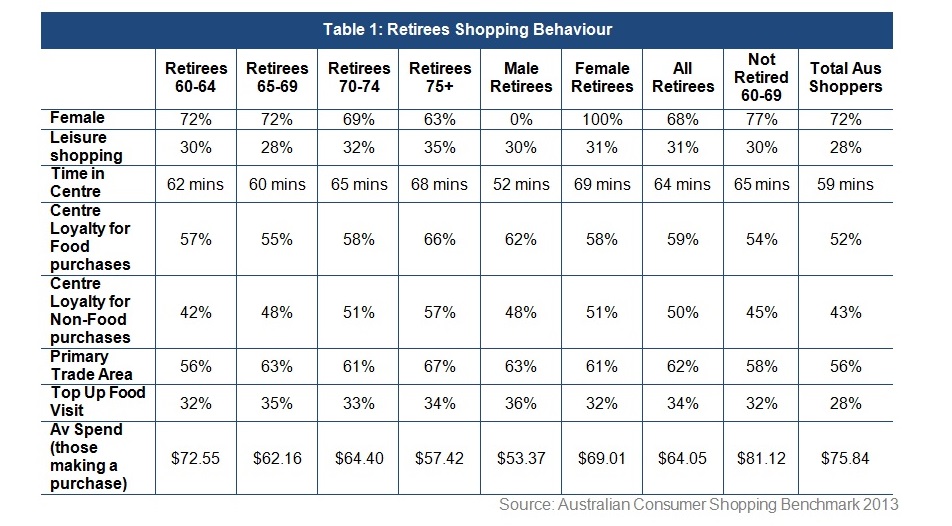In a steadily aging population, catering to older shoppers is going to be increasingly important to shopping centre managers and retailers. Already retirees make up 21% of visitors to Australian shopping centres, and a survey conducted in Melbourne in 2008 found shopping centres to be one of the most frequently visited facilities for senior Australians. More broadly, 46% of Australian shopping centre visitors are 50 years of age or older.
But how well do we cater for these customers? One international study found that most retailers fail to provide older consumers with a satisfying shopping experience, possibly because of a perception that they are not big spenders.
It’s true that some older customers do spend less, but as the chart below demonstrates, the 50-59 year, and 60-69 year age brackets are the second and fourth highest spending age groups. This makes older consumers incredibly important to the health of the retail and retail property sectors.

We noted above that more than one fifth of Australian shopping centre customers are retired. This equates to over 350,000,000 visits to centres by retirees every year. These shoppers average more time in centre, are more leisurely in their shopping approach, shop more locally, and are more loyal to their home centre. They do, on average, spend less on most categories and overall, but the average total spend for customers making a purchase is still a healthy $64 a visit.
The value of older shoppers is further reinforced when we look at those in their sixties who have not yet retired. When they go to a shopping centre and make a purchase, they average over $81 a visit. In general terms, it is retirement not age that impacts on expenditure.
In the table below we’ve provided some breakdowns of shopping behaviour. You can analyse these at your leisure, but some trends do stand out: declining spend with age in retirement, even as leisure shopping, loyalty, localisation and time in centre increase. Males retain their habits in retirement, while women still appear to enjoy the shopping centre environment more.

From both their shopping frequency and their expenditure, it’s clear that older shoppers make a substantial contribution to the retail bottom line. So it’s essential that we cater to their and ensure that they leave our centres and shops satisfied.
Research studies have found a range of factors that are important to older consumers: short queues, discounts, access to products, good customer service and easy parking. Sounds like a lot of us doesn’t it?
But looking at negative factors that have been identified – inappropriate shelf height, long queues, poor customer service, illegible labels and signage, and unsuitable package sizes – we start to see the reasons why these factors impact on older consumers’ shopping satisfaction.
Older people get tired more easily, so waiting in queues is not only frustrating, it can be exhausting. Poor customer service can seem disrespectful, not the way ‘things should be done’, or even a sign of decline of social standards.
Labelling and signage need to be legible – if they aren’t, those customers who can’t read them are excluded. And if customers can’t reach, find, or traverse a distance to access a product, they won’t buy it. Think shelf height, clear organisation and signage, and empathetic layouts or services to better facilitate access across the centre.
As always it comes down to understanding the customer, and meeting their needs and expectations. This is really about service. We tend to think of customer service as helpful assistance at the shop front, but it should be about creating satisfaction across the entire retail trip from pre-purchase behaviour onwards. Did we mention this requires research?
